Gaming Studio, Inc.
New 2018 Electronic Wheel Games
New electronic wheel games that provide security efficiency and regulatory comfort
Electronic Bingo, electronic pull tabs, now capturing the enhanced accountability, security and efficiency inherent to cyber-technologies
applied to our popular mechanical wheel games.
Organizations providing public benefits enabled with funds raised through charitable gaming should be provided the most efficient and secure methods for operating and protecting their games. This means using systems that can reduce needless time-consuming hand calculations and counting, eliminating costly error while providing for timely recognition of suspicious anomalies. On the way, it can mean providing new features to antiquated games that reverse player erosion.
Gaming Studio has a design bias toward social gaming. Any time we can embed features that connect players, we augment the experience in play. Whether it is making vehicles to invite group or party-play of wall mounted passive wheel games spinning every four minutes or producing new table games, we are always on the hunt for ways to connect players, or at the very least let them know how others are playing the same game.
"Project Ralph" Circa 1990 - Our First Electronic Wheel - aka "Wheel with Pocks"
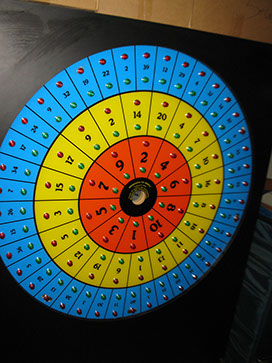
While the Richardson's earliest written plan for electronic wheels was prepared in 1990, the wheel to the left was actually built and functioning in as a rudimentary prototype in 1992. The wheel to the left had a green and a red light in each segment of each of the three rings of the wheel. The red lights in each ring were considered "Track A" while the green lights were "Track B." A separate circuit board controlled each of the six light tracks. A charitable version of the wheel would have only Track A lights, thereby having 3 random events for each spin. Players could bet each of the rings as they currently do with regard for the mechanical wheel or they could bet a combination of one number in each of two or three independently randomized rings for a higher payout. The wheel shown, with three Track A events and three Track B events allowed for a 1:64,000,000 probability of matching the exact number in six independently random rings in a single integrated spin. That probability would make the game ripe for lottery as a replacement or augmentation to the draw games using balls.
Attempts to develop Project Ralph evaporated by the end of 1998 to rise again thirteen years later, in 2011, as the following design line emerged.
Passive Wall Units
Electric Tri-Wheel® Network - Main On Site Game Display
Think of the display below as a 70” diagonal monitor (65” x 43”) hanging against a wall in the bar or gaming area -- maybe two of them in different rooms. The wheel is about 38” in diameter. Every 4 or 5 minutes, the wheel goes into a simulated spin whereby each of the three rings spin fast to begin and then slows, and slows, and slows, click, click, click until they each come to a stop.
Bets for the coming spin are not accepted after this time.
Sequential spin number for this day.
Sequential spin number for this day.
The three columns show the past winning numbers in the order of last on top. The fourth column (right) shows where it applied to odd or even.
These black disks with the red H in the center indicate “House Numbers” for purposes of “Odd” and “Even.” In other words, both “Odd” and “Even” wagers lose when a number whose segment contains the red “H” wins.
Every 4 or 5 minutes the wheel goes into a simulated spin
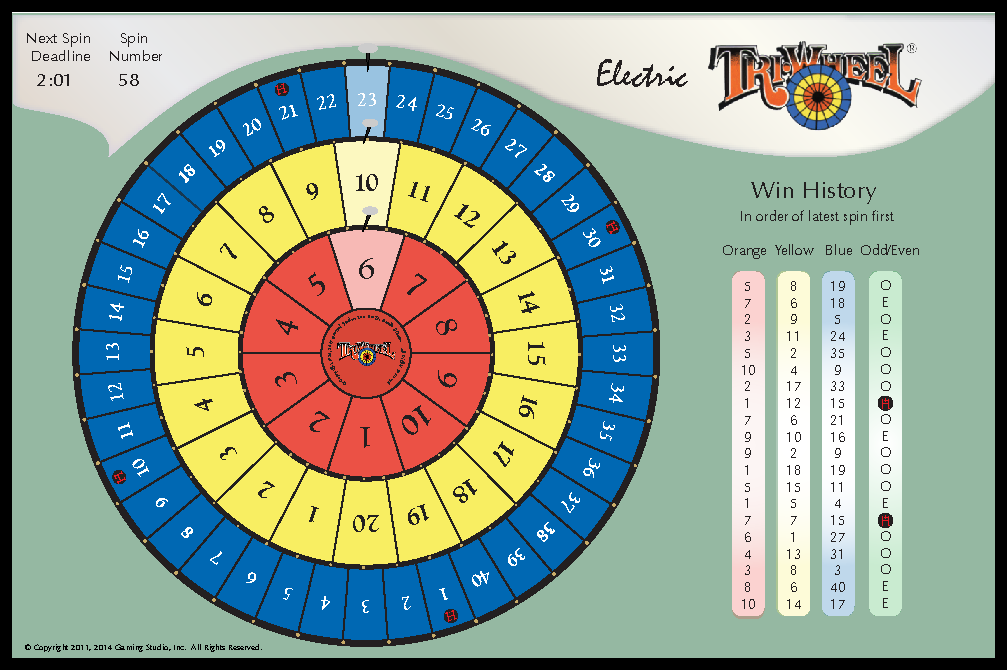
When the wheel stops, the winning segment will be illuminated as shown above for Blue 23, Yellow 10 and Orange 6.
Electric Tri-Wheel Network - Ancillary Betting Display
The betting display is meant to be of a similar size as the main display above. It hangs on the wall of the bar providing everyone with a view of how others are betting in that bar. We are trying to provide some of the same social sense of how the game is going that people sitting around a table get. In addition to seeing where other players are betting, you can see how many other players are in play. The numbers on the chips are dollars, rounded up to the next whole dollar. As the wheel spins, all of the possible winning locations, except for the multi-ring combos will light up as the wheel passes each segment on the wheel. By doing this we provide a bit of a light show but more importantly players get another image of how their wagers may be coming close - or not - to winning. The display is showing results for Blue 23, Yellow 10 and Orange 6.
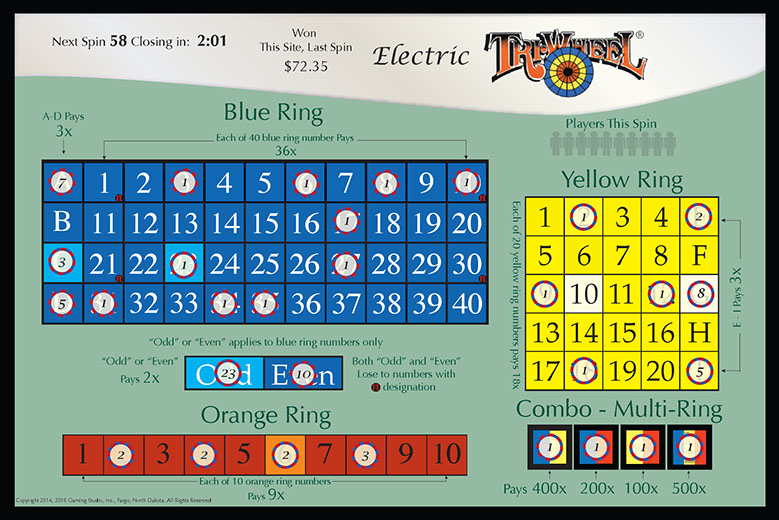
Sequential spin number for this day.
Bets for the coming spin are not accepted after this time.
Payout multiple is posted for each of the bets.
Total Amount won on this site from last spin.
Chip images indicate where players are betting on the next spin, rounded up to the next whole dollar.
Indication of quantity of players based on quantity of tickets scanned in valid for the next spin.
This area shows the ring combinations that players are betting.
Instead of tickets in slots - tickets with dots
Paper Electric Tri-Wheel® Player Selection Form
-filled.png?crc=409354000)
Players find the form on the left in stands on their cocktail table or at the bar. They darken the exact numbers they wish to play. Darken either “Odd” or “Even” and then darken how many units they wish to wager on "odd" or "even." Players liking the long-shot of multi-ring combinations, write the exact numbers in each box associated with a ring they wish to wager in combination with a number from another ring. They then darken the quantity of units 1-3.
In the case of the example on the left, they have chosen to bet 3 Blue Ring numbers, 3 Yellow Ring numbers and 3 Orange Ring numbers for 10 exact numbers. They have "hedged" their choices with 10 units of Even and then gone for the long shot on a triple combination betting that the number 2 will come up in Blue, Yellow and Orange -- for the large payoff multiple. But, what are these bets worth? How much do they all cost? Read on Working with Units next.
Working with Units
The Parlor Tri-Wheel™ uses a dynamic pricing system for wagering. By this we mean, you determine the value of each unit wagered by dividing the total quantity of units bet per spin into how much you chose to bet per spin. Let’s say that you pick the selections above: 9 exact numbers, “Even” for 10 units and one Multi-Ring Combination for 1 unit1. You have selected in total 20 units. You wrote $3 for “Amount per spin." $3.00 divided by 20 units selected = 15¢ per unit. Therefore, the payoff for hitting an exact number in Blue is 36 x 15¢ = $5.40. The payoff for hitting 10 units of "Even" is 2 x .15¢ x 10 units = $3.00. The payoff is calculated by the terminal when the ticket is scanned in for collection.
If you wished to bet $1 on each unit, you would have to commit $20 per spin. The beauty of the dynamic pricing is that players can have a whole lot of fun staying within their risk appetite. We could say, with the use of the electronic network, it no longer has to be one price fits all.
Official Electric Tri-Wheel Ticket
Derived from scanning paper or mobile device Player Selection Forms
.jpg?crc=154532357)
Players give the above Player Selection Form and payment to a runner or clerk who will have it scanned. Note, when they scan it and notice that there is something written in the Multi-Ring Combination area, the operator may have to manually enter those numbers. Once entered, the official ticket (to the left) is printed and given to the player with their selection form.
Payoffs are made after scanning the official ticket and having the computer calculate the winnings.
Alternative Method for Scanning Player Bet Selections
In addition to the paper Player Selection Form, we hope to offer the mobile device player selection form. It gets to the same place as the paper form in that it too must be scanned in order for an official paper ticket to be produced. The differences is:
- Mobile Device Bet Selection Planning Form does not waste a whole lot of paper that might be used for gaming or might as likely be used for notes at the bar table.
- Mobile Device Form allows players to plan their bet strategies off-site, save them and bring them on-site for scanning and purchase of an official ticket.
- Mobile Device Form is a clearer and more accurate way of transmitting players intention. No character reading - everything is picked up by the scannable QR code (that block of odd shapes in the lower left of the ticket and on the right side of the mobile device "order screen."
- Mobile Device has many player enhancements available, including player record/budget, ability to communicate with other players on site, more complete set of past performance, etc.
Showing a small phone edition of the mobile device Bet Planning and Selection Form. Tablet size editions will also be available.
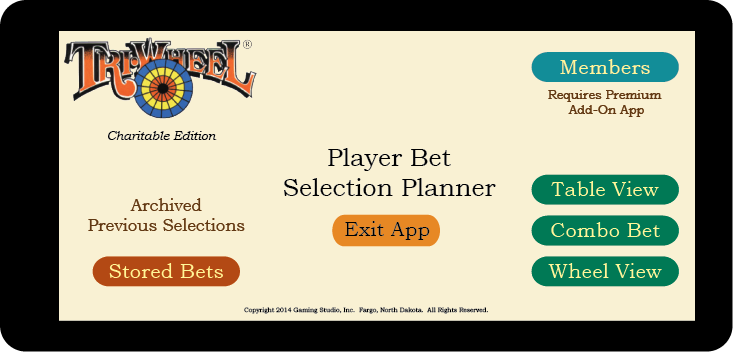
Stored Bets
Lets say four of you meet at a bar once a month to play the Electric Tri-Wheel Network. Your custom is for each of you to throw $20 in the pot. Since you have been doing this for a few months, you have saved bet configurations that you have used before. Each configuration has information with regard for where you bet, how much you bet and how many spins you buy in a row. Thus, you can go to "Stored Bets" and call up the past configuration you might wish to use. You can even modify that configuration with a tweak here and there. You don't have to go through the entire process of making bet selections.
Members
This is a premium service, meaning you pay extra, that provides additional information on past win data and greater information on the locations hosting the Pig Wheel. It also will provide a record of the wins and losses that have occurred from your play. Lastly, it aims to provide veiled messaging service among players. By veiled, I mean that you are anonymous until you make a big effort not to be. You can check on people you may have played with in the past.
Exit App
Get me out of here fast.
Table View
Takes you to the betting layout that is quite like the top of a wagering table. See below.
Wheel View
Takes you to the wheel view screen to begin picking new choices to bet on.
Home Screen
Combo Bet
Selecting the winning number in each of the three rings is like the trifacta of Tri-Wheel. This screen allows you to pick a number in two or three rings that you believe could win in the next spin. The "combo" comes from the bet being a combination of winning numbers in more than one ring of the Tri-Wheel in the same spin event.
Wheel View
This screen allows you to make bets on exact numbers in each of the three rings and on "Odd" and "Even" - remember, "odd" and "even" applies only to the blue ring numbers. Bets on the alpha lines as provided on the Table View can not be initiated from this screen; however, you can increase the units bet or delete the bet altogether from this screen. So too, multi-ring combination bets can't be initiated from this screen; however, units can be increased, decreased and the bet can be eliminated on this screen. The line bets and combo bets you have made using other screens will show up on this screen - you just can't originate them from this screen.
Exit App
Get me out of here fast.
Combo - Multi Ring
This button will take you to the screen dedicated to bets that a number winning on one rings will at the same time match a number winning in one or two rings.
Remove
Tap here and the next chip you tap will be gone - no matter how many units on it.
Total Units Bet: 25
This is saying that the player has 25 units bet totally at this time. You can't see all the bets on the wheel given that some will be line bets of multiple numbers and "Edd" or "Even."
Buy
Touching this area takes the player to the unit value screen below.
![]()
This symbol is found on four numbers, two "odd" and two "even" in the blue 40# ring. Should one of these designated numbers win, all "odd" and "even" bets lose.
Table View
Takes you to the screen below that looks like a table layout. This screen allows for line bet initiation as well as direct number and "odd" and "even" bets.
"Odd" and "Even"
Bet that an "odd" or an
Undo Last
Walks back previous bets one tap at a time. It is meant to be more slow and deliberate than "remove" button.
Chips
Each tap on a wheel segment produces a chip. More taps on the chip increase the units allocated to chips.
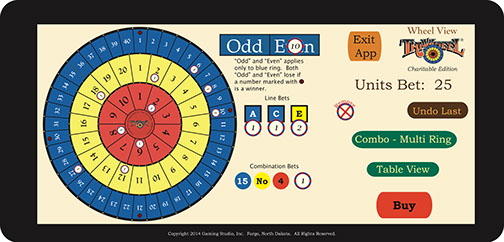
Line Bets
These are bets that have been initiated in table view, each composed of several numbers. Only the unit value can be changed or deletion of such bets can happen in this screen.
Combo Bets
These are bets that a number in one ring will win at the same time as another number or two in other rings will win. Only the unit value can be changed or deletion of such bets can happen in this screen.
Table View
This screen is called "table view" because it plays on a visual metaphor of the table top layout used for wagering. In fact, this is pretty much the same as our Tri-Wheel® table in North Dakota. This screen allows you to initiate all bets except multi-ring combinations. Tap as many times as the units you wish to bet, where you wish to bet. I believa all of the components have been explained above. I would only add that if you were to bet on blue "B," you would be betting that one of the 10 numbers to the right of "B" would win. Similarly, if you were to bet on yellow "F," you would be betting that 5, 6, 7 or 8 would win in the yellow ring.
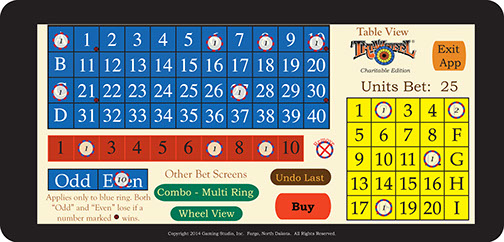
Combo Multi-Ring View
This screen is dedicated to selecting a number in one ring that you bet could win at the very same time as one or two numbers in the other rings. These combination bets provide the highest payout and also have the most remote probability of occurring. See the payout schedule.
Ring Selection
The player selects which rings they wish to play in combination by tapping the colored buttons. Note, a ring not taken is greyed out.
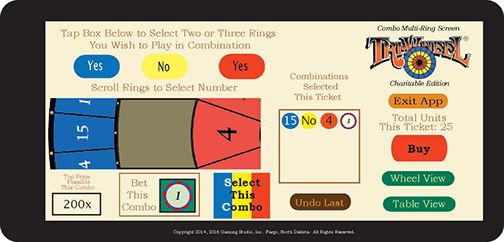
Number Selection
The player selects the numbers they wish for each of the selected rings by scrolling until the one they like is centered in the window.
Payout Multiplier
For the two rings selected, the payout maximum is 200x the value of the unit wagered.
Units Bet
On this combo, the player selects how many units they wish to bet by tapping this area for each unit desired. Depending on the jurisdiction, there is likely to be a limit placed on the value of combo bets in order to regulate payout exposure.
Confirm Selections
Touch this button to confirm the rings, numbers and units selected. Once this button is hit, the combination shows up on the right (brown box) and the ring buttons will go blank ready for another selection.
Combo Tally
This shows the combinations that have been confirmed as ready.
Combination Multi-Ring Payouts
Shown as multiples of the value of a unit.
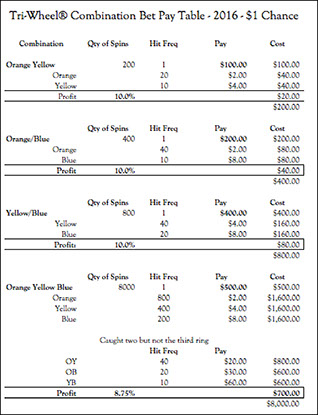
Unit Value & Ticket Pricing Screen
This screen summarizes all of the player's choices by categories and the quantity of units bet in each category. Here, the player decides how much they wish to bet per spin. At that time, the value of the units is determined but dividing the amount bet per spin by the total quantity of units selected. In the case below, the player determined that they would like to spend $10 per spin. Therefore, the 25 units selected is automatically divided into $10 to produce a per unit value of 40¢. The player wants this to apply to 10 consecutive spins. Therefore, the player knows that the ticket price will be $100. [Note: with an average payout of 90%, the player is buying a fair amount of play over 10 spins for, a total, on average spend of $10. The player still has a chance to go back into the betting screens to make changes - until they touch "Buy" and the order screen is generated. Note too, that the player has the ability to save the bet configuration at this point prior to generating an order screen. So, if they are off premise devising their bet, they can save it for recall when they are on the site prepared to have it scanned into producing an official ticket.
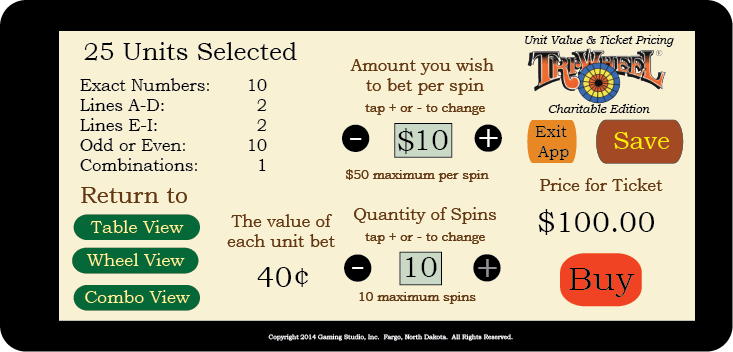
Order Screen
All previous selections are now captured in the QR code (the funny square to the right of the screen) and ready to be scanned. The player can save the selections being scanned, exit the application or return to the Home Screen to start over. Once scanned, the terminal printer produces the official ticket shown previously on this page. Again, the use of the mobile devices does not mean that the games are played from a mobile device, only that players can use mobile devices to plan and save their bet selections.
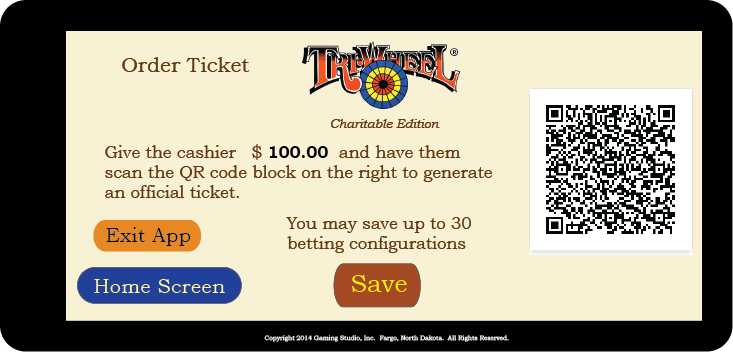
Electric Tri-Wheel® Network Configuration
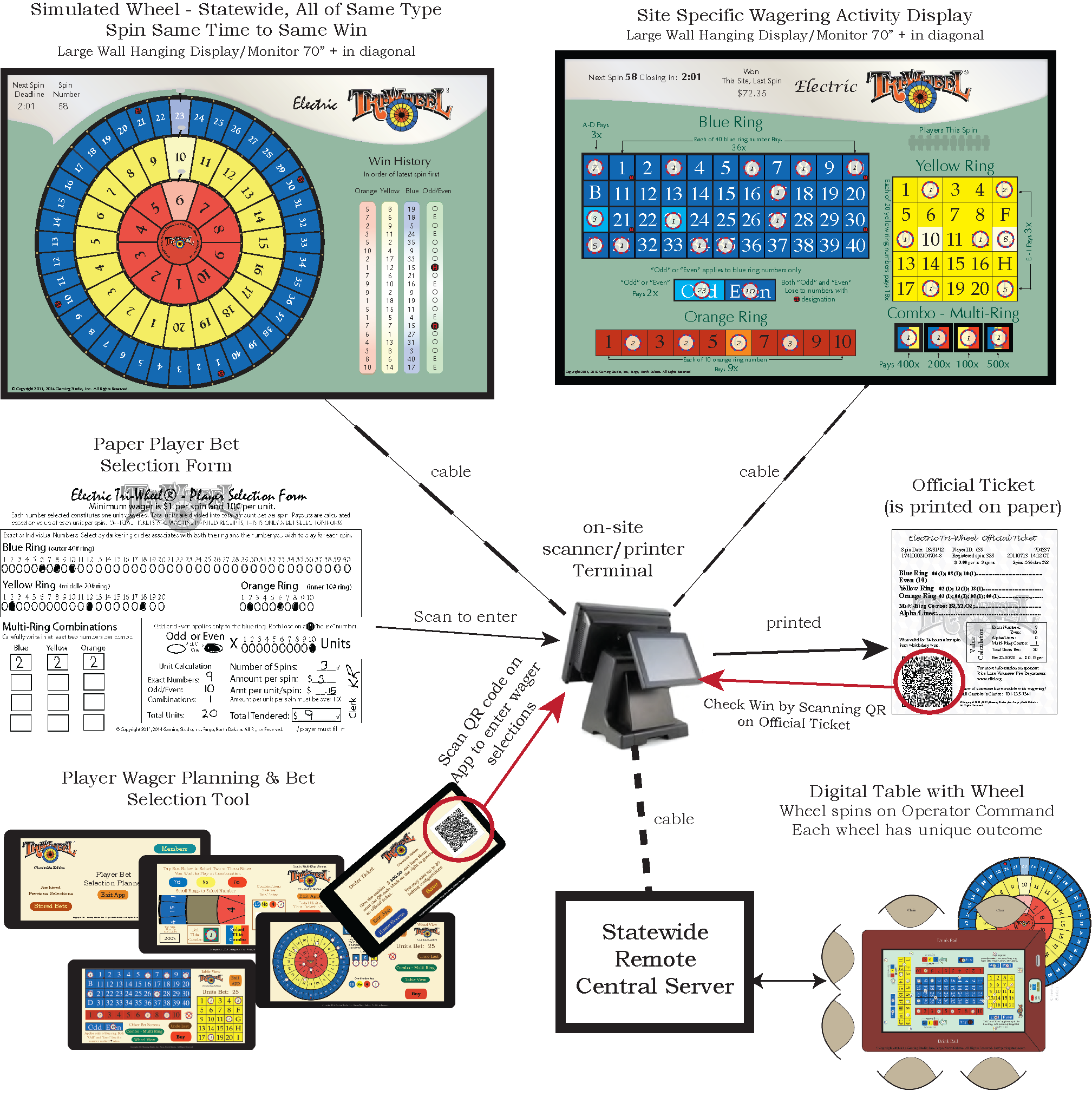
Attributes of Electronic Tri-Wheel® Network
- Random performance every spin = secure
- Greater participation without requiring players to sit at a designated and dedicated table = social
- Automated accounting and reporting = efficient & secure
- Very low transactional costs = more profitable as volume rises
- Clearer and easier method for multi-ring betting = tansactional speed & accuracy
- Computer calculated prize payouts = accuracy
- Ability of players to view where other players are betting = interesting
- Slower resolution speed (4 - 5 minutes) = responsible
- Data on past spins = nerd neat
- Display of quantity of other players on same site = social
- Ability to plan bet strategy off site to bring on site = engaging
- Ability to save bet configurations = simple
- Ability to store record of wins and losses = responsible
- Multi-ring combination wagering strategies = fun
- Ability to know what the cash bank should be in real or near real time = secure, efficient and regulation-friendly

This network is a concept game that is not in play. Leveraging our existing mechanical Pig Wheel currently in over 50 bars in North Dakota. While we hope to establish this edition of the Pig Wheel, we do not want to eliminate the physical table edition whereby players place chips on a felt layout. We anticipate being able to provide electronic wheels for table games.
This electronic network version would be appropriate for more locations where the volume of play may not be great enough to support a staffed wheel. This game brings greater efficiency, security and accountability over the mechanical wheels. As importantly, it brings heightened entertainment. Each time one of the five pigs is indicated as a winner, an animation will reveal more of the character of that particular pig. From the glitz of "Roxy" to the dry clarity of "Bob," players will get to know the pigs they bet on and how those pigs think of each other and the broader context of life. The Pig Wheel becomes the first and only wagering game using winning symbols to weave a serial story.
A certain group of birds have alleged that a few pigs stole their eggs. This false and malicious, fictional, allegation has been leveraged internationally to successfully promote a hit line of games wherein some self-serving birds are stars. The pigs on our wheel have remained silent knowing how unjustly their friends suffered from this wrongful affront. With your help, the pigs of the Pig Wheel will stand up to those disturbed, malicious, bullying and slanderous birds in defense of honest, smart and majestic Suiformes (that'd be pigs) everywhere. Help pigs defend themselves.
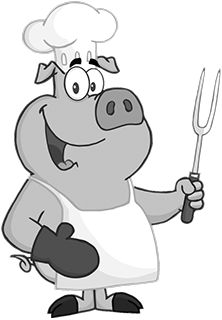
On behalf of all pigs, thanks for your interest in Pig Wheel™.
A good bird is a cooked bird. How do you like yours done?
Remember to squeal on bacon-eaters.
To Minnesota legislators, we ask that you modify definitions of paddle tickets and allow symbols, at least in the form of named pigs, on paddle wheels and modify the ticket-based prize limit to reflect the use of one ticket for, effectively, dozens of wagers.
To North Dakota legislators, we ask that you add "electronic" to definition of wheels, modify the requirement that chips and tables always be used for wheels that award "a variable multiple of the wager" - given our more secure system and modify the chip/ticket based prize limit to reflect tickets that contain several wagers. Also, the prize limitation must be modified to reflect a ticket that contains, effectively, the equivalent of dozens of old-style tickets.
To licensed charitable organizations, we ask that you support giving the electronic pigs their voice, their public, and ask that your gaming association, Allied Charities of Minnesota and Charitable Gaming Association of North Dakota testify in favor of legislation allowing electronic wheels.
To the Control Board in Minnesota and the North Dakota Attorney General's Office, Gaming Division, we welcome your scrutiny over the behavior of our honest pigs, pigs who know how to count, pigs who will make sure every penny goes exactly where it should. After all, banks have been named “piggys” for generations. Don't believe those rumors that pigs steal eggs....
PIG POWER! Viva la Pigs --------------- and, eat disturbed birds as they pollute the avian gene pool and taste delicious!
Main Game Display
The Main Game Display is meant to be a large (70"+) flat panel television or display that hangs on the bar wall. It is from this display that the wheel will go through simulated rotating spins, slowing to eventually stop at the winning number or pig. All such displays in the state would spin at the same time and would show the same number or pig as a win. The display provides players with a clock count down to the next spin and 20 - 30 seconds prior to that next spin, the clock numbers will turn red to indicate that betting for the next spin is closed. The spin number is for reference on the ticket in knowing which events the ticket was valid for use. The "Win History" merely gives players an indication of what recently won so they can check their tickets or bet according to whatever they believe past wins tell them. If a pig is shown as a win, a brief animation will show whereby that winning pig shares a very short story or thought about themselves, the other pigs, those disturbed birds or something entirely else.
.png?crc=517514539)
Ancillary Betting Display
The Ancillary Betting Display shows all of the bets placed for the very next spin from players on the same site. This way players can see where others are betting. The numbers are denominated in dollars (rounded up to the next nearest). As the wheel spins, all of the locations that would make win lighten up, for instance the number "1" also brings a win to "A", "E" and "Odd." So as the wheel rotates by the numbers, the potential wins follow on this display. This display also shows the number of players playing, as evidenced by the quantity of tickets sold. It informs players of the payouts and how much was won from the last spin on this site. This display would be 70" as well.

Betting
There are two ways to transmit your bet selections to the terminal in order that you receive a printed official ticket. The first method is through filling out a paper Player's Selection Form. These forms are likely found in a pocket at the side of tables in bars and restaurants where the game is played. The second method for transmitting players bet selections, is through mobile phone or tablet generated QR code that is scanned to generate an official printed ticket. The electronic method of selecting bets saves a great deal of paper and it can actually be more accurate and lead to less confusion. Players can better balance their betting being able to select more than one unit on each type of game. We hope that years down the line, we would be able to drop the paper Player's Selection Form in favor of electronics; however, we know that many people still aren't quite as comfortable with electronics.
As can be seen in the above Ancillary Betting Screen, there are several different ways to bet the wheel:
1. Exact number: Individual numbers 1 - 40. Any win on an exact number bet pays 40x bet.
2. Lines A - D: A bet on any of these four alpha bets is a bet that the ten numbers to the right of the alpha will win.
Should that happen, the player would be paid 4x their bet.
3. Lines E - N: A bet on any of these ten alpha bets is a bet that the four numbers above the alpha will win. Should
that happen, the player would be paid 10x their bet.
4. "Odd" or "Even": A bet that an odd number or an even number will win. Should that happen, the player would
receive 2x their bet.
5. Individual Pigs: A bet on an individual pigs should they prove a winner will pay 40x the bet amount.
6. Both Blue Pigs or Both Pink Pigs: If on of the pigs whose color you bet by placing a wager on Both is indicated a
winner, you would be paid 20x the amount bet.
7. All Pigs: This is a bet that any pig would be found a winner and if successful, it pays 8x the amount bet.
 Betting Units
Betting Units
The value of a unit is determined once a player decides how much they wish to bet per spin. In the example to the left, the player has chosen 20 units to wager. Note the only place the player could select more than one unit is on "Odd" and "Even." The player chose 10 units of "Even" along with two exact numbers, lines A, C, G and K for 4 units and two exact pigs, Sue and Joe, along with Any Blue Pig and Any Pig of any color. The player has then elected to bet $5.00 per spin. Dividing $5.00 by 20 units means that each unit is worth 25¢. Thus if number 3 wins, the prize would be 40 x 25¢ = $10.00 + Line A 25¢ x 4 = $2.00 + Line G for 25¢ x 8 = $2.00 or for the ticket, $14.00.
If the player had decided to bet $10 per spin, they would have won $28 if number 3 was inicated a winner.
The minimum value of a unit is stated to be 10¢ (it is up to the regulatory agency - could be 5¢ or something other) and players must bet at least $1.00 per spin just to pay for the ticket processing.
Once the player has marked their selections on the paper form, they provide the form and, in this case, $50 (10 consecutive spins at $5.00 each) to a clerk or bartender in Minnesota. The Form is scanned into the statewide central computer server and an official ticket is printed. It is likely that regulations would allow players to buy no more than ten consecutive spins.
-filmatch.jpg?crc=253794044) The official ticket is primarily an indication of who owns the wagers that are made on the ticket while the wagers themselves are stored by the system. The physical ticket and the stored information should never differ.
The official ticket is primarily an indication of who owns the wagers that are made on the ticket while the wagers themselves are stored by the system. The physical ticket and the stored information should never differ.
Example: This 1 ticket equals 200 tickets under current Minnesota law.
The ticket has 20 wagers per spin for 10 spins. Placing 200 wagers would currently require 200 tickets in Minnesota. That is 200 tickets that would have to be counted, written on, discarded, have the winning amount written on along with the winning slot circled or noted and then stored as a record for years. The ticket supply alone for 200 tickets would cost close to 50¢ and then the greater expense of controlling, accounting and auditing would be added. Using the ticketing system for this edition of the paddle wheel is considerably less expensive. The ability to audit and to reconcile to on-site cash bank is near real-time.
Scan to Collect on Wins
Players scan or have their tickets scanned for payout. The green squared QR code contains information on all of their betting choices; however, it calls from the server the record of win and the amounts that should be paid. If the face of the paper ticket has betting information not found in the QR code and the server, we probably have a creative player needing prosecution.
Depending on jurisdictional regulations, we could provide scanning terminals allowing players to check their ticket prior to all of the spins contained have been conducted. On the other hand, some of these operations are made a bit easier with the mobile Player Selection Form below.
Mobile Digital Player Bet Selection Planner
The mobile the same essential function as the paper Player Selection Form, except that it provides players with more information and give greater clarity in transmitting the player's selections to an official printed ticket. The mobile Planner and Selection Form saves organizations the expense of having to stock paper forms at the tables in their sites. What follows are five basic screens that give you an idea of the scope of the application. In the end, this still leads to the same place as the paper form - to a scan for transmitting information that produces a paper printed official ticket (above) that needs to be presented for a scan to collect on bets.
Home Screen
Stored Bets
Lets say four of you meet at a bar once a month to play the Electric Pig Wheel Network. Your custom is for each of you to throw $20 in the pot. Since you have been doing this for a few months, you have saved bet configurations that you have used before. Each configuration has information with regard for where you bet, how much you bet and how many spins you buy in a row. Thus, you can go to "Stored Bets" and call up the past configuration you might wish to use. You can even modify that configuration with a tweak here and there. You don't have to go through the entire process of making bet selections.
Members
This is a premium service, meaning you pay extra, that provides additional information on past win data and greater information on the locations hosting the Pig Wheel. It also will provide a record of the wins and losses that have occurred from your play. Lastly, it aims to provide veiled messaging service among players. By veiled, I mean that you are anonymous until you make a big effort not to be. You can check on people you may have played with in the past.
Exit App
Get me out of here fast.
Table View
Takes you to the betting layout that is quite like the top of a wagering table. See below.
Wheel View
Takes you to the wheel view screen to begin picking new choices to bet on.

Exit App
Get me out of here fast.
Remove
Tap here and the next chip you tap will be gone - no matter how many units on it.
Wheel
Players can rotate the wheel by swiping left or right.
Total Units Bet: 19
This is saying that the players has 19 units bet totally at this time. You can't see all the bets on the wheel given that some will be line bets of multiple numbers and "Edd" or "Even."
Table View
Takes you to the betting layout that is quite like the top of a wagering table. See below.
Buy
Touching this area takes the player to the unit value screen below.
Whole Wheel
See the entire wheel. The segments on certain mobile devices will be too small to be in this view.
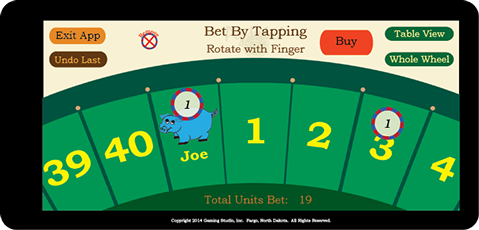
Undo Last
Walks back previous bets one tap at a time
Chips
Each tap on a wheel segment produces a chip. More taps on the chip increase the units allocated to chips.
Wheel View Screen
.png?crc=286120564)
Exit App
Get me out of here fast.
Remove
Tap here and the next chip you tap will be gone - no matter how many units on it.
Total Units Bet: 19
This is saying that the players has 19 units bet totally at this time. You can't see all the bets on the wheel given that some will be line bets of multiple numbers and "Edd" or "Even."
Buy
Touching this area takes the player to the unit value screen below.
Wheel View
Takes you to the wheel view screen to begin picking new choices to bet on.
Undo Last
Walks back previous bets one tap at a time
Chips
Each tap on a wheel segment produces a chip. More taps on the chip increase the units allocated to chips.
Table View Screen
Exit App
Get me out of here fast.
Table View
Takes you back to the betting layout that is quite like the top of a wagering table. See above. This would likely mean that you want to change a bet.
Buy
From this screen "Buy" goes to the scannable QR code screen to be scanned into the system and print an official paper ticket.
Unit Value Screen
Units Selected
This is a breakdown of the units selected elsewhere on the Mobile Bet Selection Planner.
Per Spin
Player picks the total amount they wish to bet on each spin for which this bet selection will apply. The maximum allowed per spin may vary by jurisdiction.
Quantity of Spins
The player designates how many consecutive spins they wish the bet configuration to apply toward. The 10 spin limit may vary by state.

Value of Units
This is a calculated field. If the player bets 19 units and wishes to spend $5 per spin, (5.00/19) = 26.31¢ per unit. Rounded down that would be 26¢ per unit.
Price per Ticket
Calculated field resulting from selecting $5 per spin and 10 spins. The ticket issued will be for all 10 spins - $50.00
Save
Touching here will pull up a screen allowing the player to title this bet configuration for future use. It will also be saved by date.
Order Ticket Screen
Exit App
Get me out of here fast.
Home Screen
Takes the player back to the very beginning whereby they can access the members premium area, stored bets, or begin the bet planning all over.
QR Code
This form of bar code contains all of the betting choices the player has made, including amounts, quantity of spins, etc. When this is scanned, all of those choices are registered in the network and the official ticket is printed - if the player paid the amount shown on this screen.
Save
Touching here will pull up a screen allowing the player to title this bet configuration for future use. It will also be saved by date. This is the second and last chance to save the configuration.
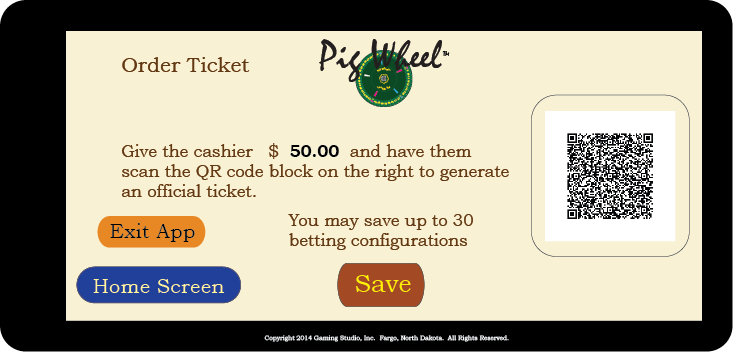

.png?crc=3914769751)
Attributes of Electronic Pig Wheel® Network
- Random performance every spin = secure
- Greater participation without requiring players to sit at a designated and dedicated table = social
- Automated accounting and reporting = efficient & secure
- Very low transactional costs = more profitable as volume rises
- Humorous caricatures and serial fiction snippits = increased entertainment
- Computer calculated prize payouts = accuracy
- Ability of players to view where other players are betting = interesting
- Slower resolution speed (4 - 5 minutes) = responsible
- Data on past spins = nerd neat
- Display of quantity of other players on same site = social
- Ability to plan bet strategy off site to bring on site = engaging
- Ability to save bet configurations = simple
- Ability to store record of wins and losses = responsible
- It's about pigs = fun
- Ability to know what the cash bank should be in real or near real time = secure, efficient and regulation-friendly
New Wheel Tables
Electronic Tri-Wheel® Table Minnesota
Upgrading the 1986-1991 Edition
Note: This table is not currently legal in Minnesota and can't be offered for sale.
Once authorized, the actual table made available to licensed distributors in Minnesota may vary subject to final rule making.
Designed to bring enhanced accuracy, efficiency and entertainment value over the existing wheel related table. The new table reduces error from tedious counting and recording of tickets and chips and calculating payouts. It saves tons of paper while reducing the management time consumed in reconciling chip records to ticket records to drop box and on-site cash bank records. All chip purchases, bets, payouts and even tips are recorded automatically. The shift or nightly closing report informs of exactly how much money should be in the table drop box and in the cashier's (pull tab ticket clerk's) table bank. Relieved of the more mundane and monotonous tasks, the wheel operator can focus more on the players. This is exactly where entertaining forms of neighborhood gaming should concentrate - ensuring players have fun for their money. When the value of a good time at the right price is met, players will return to make gaming a regular night out.
Example below is approximately 3' x 5', inclusive of drink rail (red/brown). The light green area is all electronic touch sensitive display that would rise 5 or 6 inches above the drink rail. The section on the right is the operators station with a separate screen used to issue and redeem chips, accept tips, order spins. The table seats comfortably six players.
Conduct Summary and Comparison to Existing: The existing Minnesota Tri-Wheel® has players passing money to the wheel operator who then provides the player chips of equivalent value. The cash is plunged into a double locking drop box mounted and locked to the table. So far, this is exactly what will happen on the electronic table; however, the chips are virtual and the operator does not need to count them out. Instead, the operator enters the amount received and the denomination of the chips desired by the player, the computer provides the right quantity of chips to the position at the table the player is sitting (1 - 6 beginning on the left of the operator). Each position has different colored chip rim combinations.
A big difference between this table and the original is that players do not need to acquire serial numbered paper tickets for each of their bets, mark their unique identifier on the back of each ticket and place all of the tickets they purchased in slots associated with each possible bet on the table. Instead, players merely move their chips to where they wish to bet. Of course, all of the chip traffic on the table is recorded, providing greater accuracy and much quicker auditing than with the existing chip - ticket system. The numbers on the chips at each player position is indicative of the quantity of chips that player has, not the value of the chips. One player may be using $1 chips while another could be using 10¢ chips while still another is using 50¢ or $2 chips. The system knows the value of each person's chips.
Once the wheel has gone through a simulated spin, the losing bets vaporize in a poof of smoke while the winning bets have their chips expand and pop up to the amount the bet has won as they move to the players stack added to the players previous balance. The operator does not need to manually figure out how much to pay the player, mark each of the winning tickets (their are none) with the amount being paid and count out the winning amount of chips and slide them over to the player. That is automated. There should be no room for error by the operator in payouts. There should be no operator or environmental bias in the wheel. This is accurate and efficient without the need to securely store, count and audit thousands of tickets. The operator can spend their time making sure the player's questions are answered and in keeping an entertaining and fun atmosphere at the table.
Six Player Table
Approximately 5' x 3' (not counting the wheel display)
.jpg?crc=458859154)

Placing bets: Instead of placing tickets in slots, players move their virtual chips to where they wish to bet. Want to bet two chips - move another on top of the first. Once the wheel operator has ordered a spin, the table is locked down - nothing moves or changes until after the spin and the payout.
Example of Bet Placement Options Presented for Yellow Ring
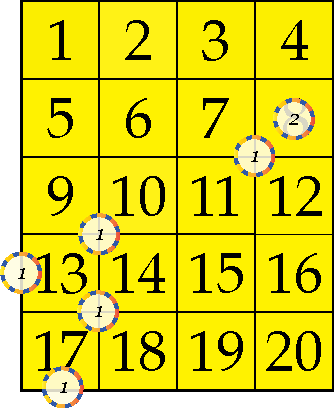
Row Bet. Placing the chip on the line outside a row of numbers means a bet that any of the four numbers in the row (13, 14, 15 or 16) will win. If so, the player would win 1/4 the multiple of a single exact number bet. This bet does exist on the slotted table.
Column Bet: By placing the chip on the line below a column of numbers, the player is betting that one of the five numbers ( 1, 5, 9, 13, 17) in this column will appear a winner in the next spin. If the player has guessed right, they will receive 1/5th the multiple that they would have received betting an exact individual number.
Exact Number: Standard bet available today - a bet that that very number will appear as a winner in the Yellow Ring.
New bet. A "Quad" whereby the player is splitting their bet among four numbers. Any one of those numbers appears as a winner in the yellow ring, the player wins 1/4 the multiple they would have won with a standard exact number bet.
Example of Bet Placement Options Presented for Blue Ring
Column Bet: By placing the chip on the line at the head or foot of a column of numbers, the player is betting that one of the ten numbers (31 - 40) in this column will appear a winner in the next spin. If the player has guessed right, they will receive 1/10th the multiple that they would have received betting an exact individual number.
Exact Number: Standard bet available today - a bet that that very number will appear as a winner in the Blue Ring.
Row Bet: A bet that one of the four numbers (4, 14, 24, 34) will win.
Pair or Slit Bet: A bet that either 19 or 29 will win. If so, the payout would be 1/2 what an exact number bet would provide.
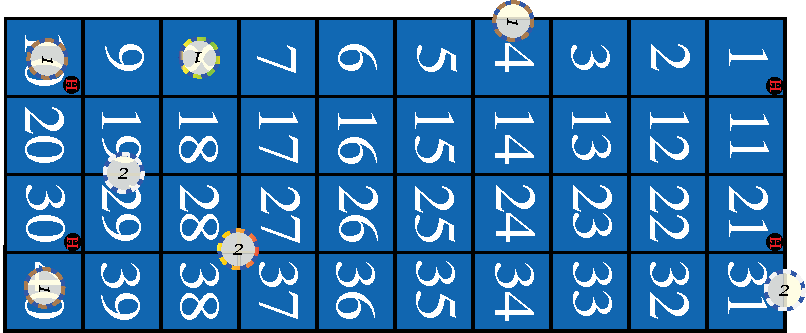
New bet. A "Quad" whereby the player is splitting their bet among four numbers. Any one of those numbers appears as a winner in the yellow ring, the player wins 1/4th the multiple they would have won with a standard exact number bet.
New Blue Ring Bet


This is not a new bet. Instead of taking six numbers for the "house," as with the manual table, we advise taking only four. Part of the reason is that there is no longer a cost associated with each bet (ticket costs were in the neighborhood of 2.6¢ each or 2.6% of a $1 bet). Absent that cost, the players should be given a better deal.

Orange Ring Betting - Nothing New

A New Bet - Multi-Ring
The electronic nature of the Tri-Wheel® allows for each ring to be separate random events within one larger spin context. Thus players are able to bet an exact number in one ring coupled with one or two exact numbers in other rings. Below are three different examples. The first shows the non-use static state where all rings have "0" meaning no selection while the second shows selections only in the Blue and Orange Rings and the third shows selections in all three rings.


Multi-Ring Bet: Player is betting 1 unit that "2" will appear in both the Blue and the Orange rings.
Multi-Ring Bet: Player is betting 1 unit that "21" will appear in the Blue Ring at the same time as "11" appears in the Yellow Ring and "1" appears in the Orange Ring. Should this happen, the maximum payout would be 500 times the value bet.

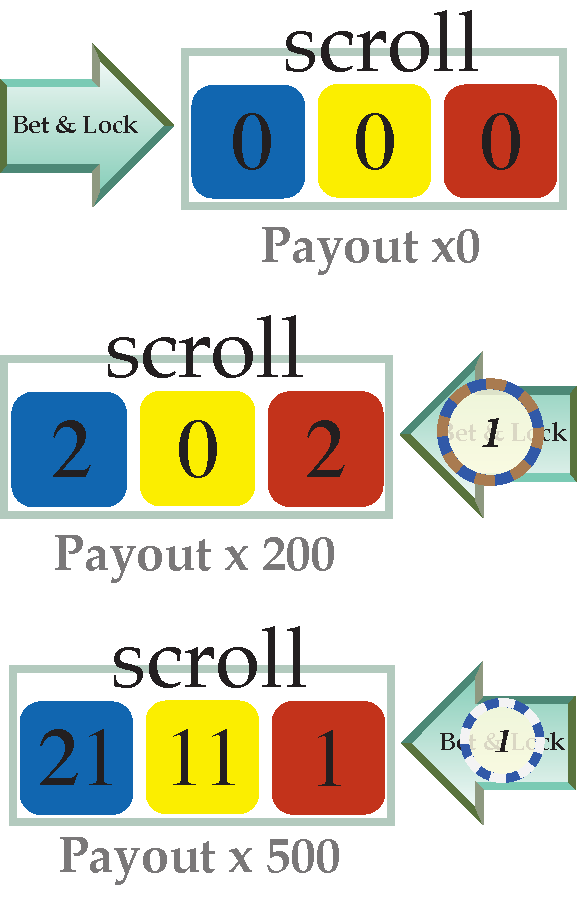
Payout: After a spin is completed, the losing chips blow up (simulated puffs of smoke as they disappear), followed by the winning chips expanding in size and wracking up numbers with some dedicated sound. The payouts are all automatically calculated by the computer. Generally, we are recommending payouts that allow for a house advantage of 10%. This compares with approximately a 5% house advantage in the table card game "21" which is played in tribal casinos. The game needs to be competitive.
Electric Pig Wheel® Table Game - Designed for North Dakota & Minnesota
Charitable Gaming Sector
Designed for both states charitable gaming in that both are quite similar with paddle wheels that Gaming Studio's Richardson designed in the 80s and 90s. While both the very popular Pig Wheel® and Tri-Wheel® are operated in North Dakota, the Pig Wheel® is not operated in Minnesota because MN statute allows only numerals as segment identifiers and not symbols and or letters. We hope this is changed in the 2015 Minnesota session.
What the electronic table provides - North Dakota emphasis.
The electronic table continues to require an operator whose job is to explain the game, sell and redeem the chips and decide when a spin is called ("called" because the operator actually signals the statewide server to provide a spin to the wheel associated with the table ordering the spin). Given that it uses an electronic simulated wheel, the human and environmental bias is taken out of spins. Additionally, the errors in paying out winners and losers are eliminated as the computer determines which bets win and how much they are paid. No more distracting "fills" or "credits" are needed as the virtual chip bank is endless. Errors in redeeming chips are also eliminated as a computer calculated receipt is printed for the total value of cashed out chips. Closing reports are generated by the computer - printed out quickly. The computer knows how much should be in both the drop box and the cash bank. In fact, a gaming manager can remotely check during the night's play on how each of the organization's tables are performing. Reduction is staff audit and count time requirements, accuracy of play and removal of wheel bias should bring a net cost-savings over the operation of the manual game while attracting a younger audience and generally promoting more fun at the table through increased operator player attention.
Process of Play
Buying In: Player approaches the table and asks to acquire chips to play. Operator asks what denomination of chip the player would like (could be a range from 10¢ - whatever the state top chip value allows) and at which of the six positions at the table the player intends to sit. Player hands the operator cash. Operator spreads the cash on the table in front of the operators position and then hits denomination of chip desired and amount of cash tendered along with the table position. The computer sends over the correct quantity of chips to the player's position. The operator plunges the cash into the double-locking drop box which is locked to the table.
Placing Bets: A player drags a chip to the betting position they wish. If they want to bet more than one chip, they tap the number on the chip they dragged until the chip expresses the quantity they desired. After 5 seconds of no activity the quantity is set. The only way to remove chips is for the player to drag the chip bet back and begin on that bet again.
Calling the Spin: The operator having determined that betting is complete, calls for a spin by touching the spin button on the operator's console. This locks the table from any further betting action. [For fun and entertainment the players can make weird designs with the chips in their stack while they are waiting for the spin results]
Wins and Losses: After the wheel has stopped spinning, to reveal the winning number, the losing chips begin to pop and give off a little smoke image as they disappear. Once the losing chips have gone, the winning chips expand and the payoff numbers click up followed by their racing over to the appropriate players stack.
Table Open for Betting Again
Payouts: Essentially with the Pig Wheel, any exact number bet returns $40. That is because there is always the 5 pigs who can get in the way of winning any number. The game is an 11.11% house advantage. A Pair bet will return 20, a Quad bet 10, etc. A Single Pig fetches 40x bet, A Pair of Pigs 20, etc.
Six Player Table
Approximately 5' x 3' (not counting the wheel display)
.png?crc=406893554)
Simulated Wheel
6" rise
Table Detail:
Electronic Playing Surface/Table Top
Playing Surface
Drink Rail
Money slot and plunger that pushes currency down into a double-locked metal drop box attached to the table.
Wheel Operator's Control Panel from which chips are issued and redeemed and spins are called.
%20-%20display.png?crc=138072313)
Multi-touch sensitive
electronic playing
surface
Player Position 1
Showing the player's chip color and the stack of chips for this player as 123 chips.
Player Position 2
Showing the player's chip color and the stack of chips for this player as 14 chips.
Player Position 3
Showing the player's chip color and the stack of chips for this player as 47 chips.
Player Position 4
Showing the player's chip color and the stack of chips for this player as 47 chips.
Player Position 5
Showing the player's chip color and the stack of chips for this player as 63 chips.
Player Position 6
Showing the player's chip color and the stack of chips for this player as 14 chips.
Operator's Tips
The operator accepts tips through a process as yet determined. The tips are displayed to show they are accepted.
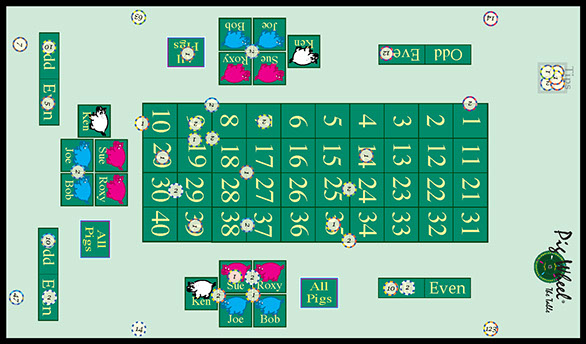
Sample Bets on 40# Block
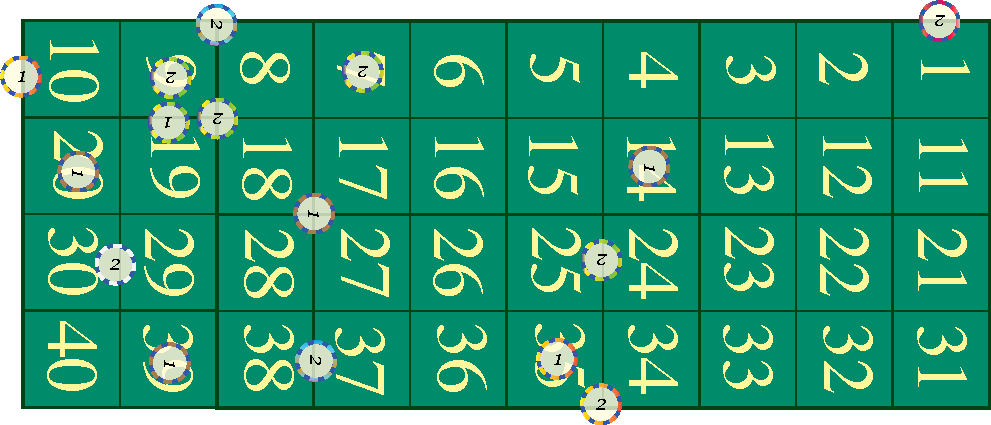
"Column" bet: Placing a chip here means a bet on any of the numbers 1 - 10 winning.
"Quad" bet: This is a bet that one of the four numbers bordering this line intersection will win.
"2 Row" bet: Placing a chip on the line at the end of a row, means both rows are bet. This is a bet that numbers ending in 8 and 9 might win.
"Row" bet: Placing a chip on the line at the end of a row is a bet that one of the four numbers in the row will win.
"Pair" bet: Betting that one of the two will be a win.
"Exact" bet: A classic bet that the exact number will show a winner.
"Odd" and "Even"
These are about as basic as it gets. Pigs are neither odd or even and therefore when a pig wins, both odd and even lose.

The Pigs
These are about as basic as it gets. Pigs are neither odd or even and therefore when a pig wins, both odd and even lose.
The pigs are like betting the numbers in that a single pig brings the same 40 back (your original bet plus 39). Two pigs bring 20 and four pigs bring 10. A 3 pig bet is the worse on the table - it brings only 13.
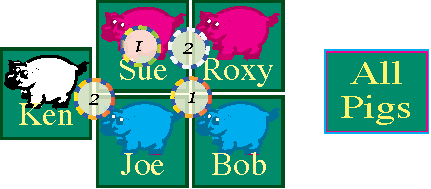
"3 Pig" bet: A bet that Ken, Sue or Joe will show as a win from the spin.
"Pair of Pigs" bet. This line brings both Sue and Roxy into play - hoping one of them will win.
"Exact Pig" bet: A bet that Sue will show as the win from the next spin.
"Quad Pigs" bet: And like a quad bet in numbers, it is a bet that one of the four pigs will show as a win.
Gaming Studio, Inc. Post Office Box 3112, Fargo, ND 58108-3112
Contact: joe@gamingstudio.com 701-388-3266
© Copyright 2013, 2015, 2019, 2020 Gaming Studio, Inc., Fargo, ND, USA. All rights reserved.